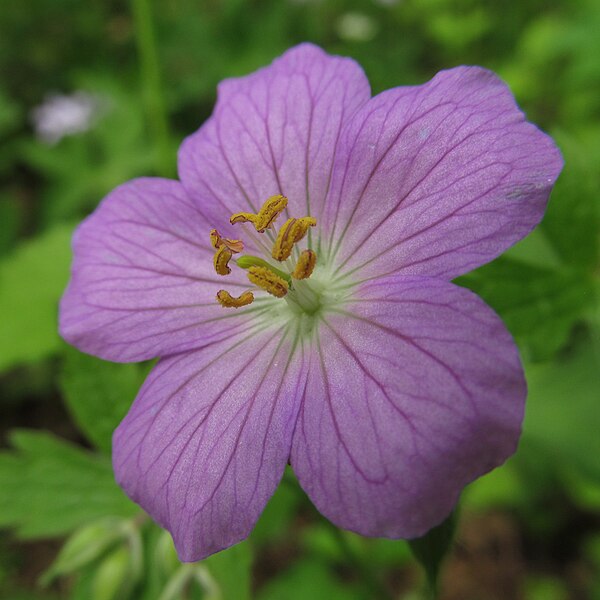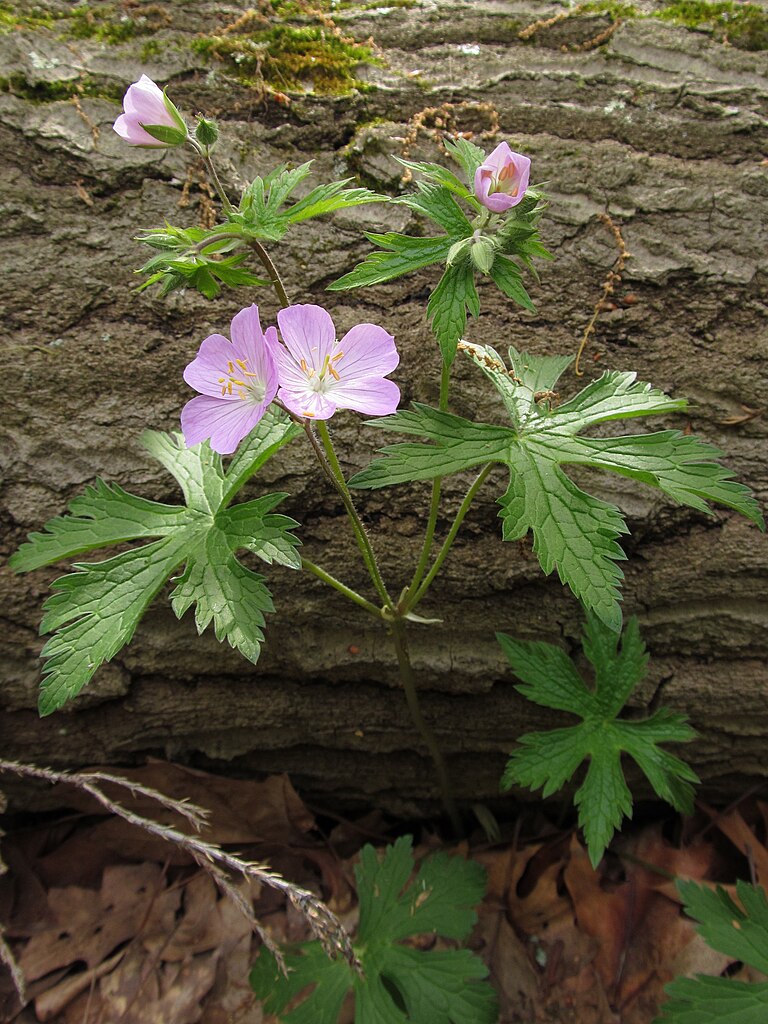

Also known as Cranesbill, because of the distinctive seedpods that look like the head of a long-billed bird. The “bill” is an ingenious spring-loaded mechanism that, when the pod dries, suddenly releases and flings the seeds into the air with amazing force. The five-petaled flowers come in shades of pink ranging from lavender to deep rose.
Wild Geranium is a popular garden perennial for shady yards; its close relatives, the florists’ geraniums (which have similar crane’s-bill seedpods), are placed in the genus Pelargonium by botanists. They bloom from late April through May.

Gray describes the genus and the species:
GERANIUM [Tourn.] L. CRANESBILL. Stamens 10 (rarely 6), all with perfect anthers, the 5 longer with glands at their base (alternate with the petals). Styles smooth inside in fruit when they separate from the axis. Stems forking. Peduncles 1-3-flowered. (An old Greek name, from geranos, a crane; the long fruit-bearing beak thought to resemble the bill of that bird.)
G. maculatum L. (WILD G.) Erect, hairy; leaves about 5-parted, the wedge-shaped divisions lobed and cut at the end; sepals slender-pointed; pedicels and beak of fruit hairy but not glandular; petals entire, light purple, bearded on the claw. Open woods and fields, centr. Me. to Man., and southw. Apr.-July.

In Our Common Wild Flowers of Springtime and Autumn, Alice Mary Dowd gives us this copious description of the Wild Geranium and its habits:
THE WILD GERANIUM
In May and June the wild geranium blossoms in the open woods and by shady roadsides. Its flowers, pale purple or pink, measure an inch or more across. They are very delicate and wither soon when picked unless they are placed in water immediately. The leaves are deeply cut and usually have five lobes. The lower ones have long stems. The upper ones are opposite and a longstemmed flower-cluster rises from between them. At the base of each leaf-stalk are two small, narrow leaves called stipules. The plant is sometimes called spotted geranium, because its leaves are marked with white blotches.
Not only the leaves and stems are hairy but the sepals too are edged with a row of hairs and the petals have little tufts of white hairs on each side at the base.
Thus the whole plant presents ways beset with difficulties to crawling intruders, and the nectar at the base of each petal is guarded from insects and from moisture.
There are ten stamens in two rows, and the outer five shed their pollen first. A magnifying glass shows us purple lines where the anthers split, and large, white, shining grains of pollen. Not until the pollen has all been scattered does the stigma open its. five fingers. Thus the flower is quite incapable of producing seed without the aid of the bees, who bring it pollen from a younger flower.
What seems to be one pistil is a cluster of five pistils attached to a central axis, which increases in length after the petals have fallen. It is this long beak that gave the plant its name crane’s bill, and the same meaning is in the name geranium, which comes from the Greek word for crane.
When the seeds are ripe the pistils split away from the base of the axis and coil upward; and the seeds, that were held within as if in the hollows of their hands, are thrown out to find a place for themselves in the world, away from the parent plant.
In moist, rocky woods and ravines grows a smaller wild geranium called herb Robert. Its leaves are finely cut, and strong-scented when bruised. The odor is said to drive away bugs, and so the plant is sometime called bug-bane.
Like herb Robert the cultivated geraniums have leaves with characteristic odors, as the fish geranium, the lemon geranium, and the rose geranium. No doubt these scents are useful to the plant in frightening away its enemies, for animals and insects have a keener sense of smell than we have. Often they dislike odors that we like, and are attracted by odors that repel us.
The cultivated geraniums are properly called pelargoniums or stork-bills. They are cousins of the wild geranium and come from South Africa, where they cover the hillsides with brilliant bloom.
More than a hundred years ago the study of a wild geranium led the German botanist, Sprengel, to discover the relations of flowers to insects. His studies convinced him that “the wise Author of nature has not created a hair in vain.”
